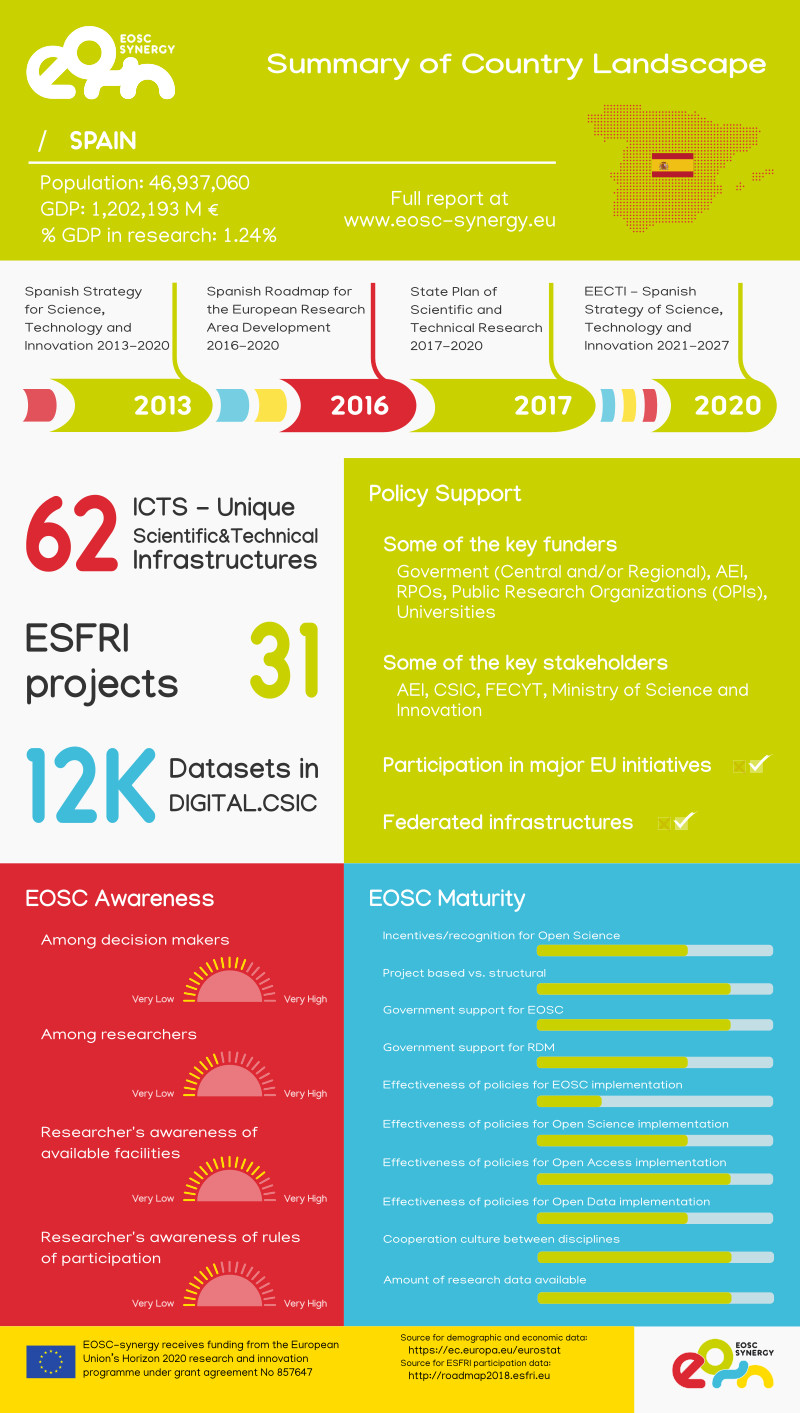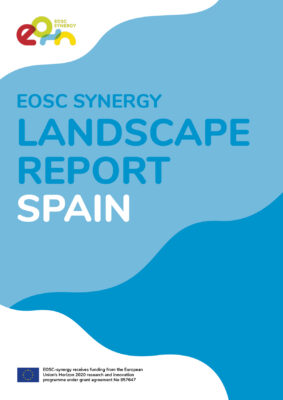

The Spanish Strategy on Science, Technology and Innovation 2013-2020is the RDI policy for the State Administration and the Regions sharing vision with Europe2020 Strategy, Innovation Union Flagship and H2020, addressing key actions in close connection to the goal of EOSC:
- To strengthen strategic planning and coordination of the Spanish Landscape of Research Infrastructures (RIs), included in the ESFRI Roadmap and in the Map of Unique Scientific and Technological Infrastructures (ICTS) through the the Council of Scientific, Technological and Innovation Policy and its Executive Commission.
- To promote e-Infrastructures and data sharing.
- To strengthen R&D Institutions for developing or improving their data infrastructures.
- To promote open access to publication and public funded research results, adopting measures, and shared standards at all levels of administrations and research institutions.
The State Plan of Scientific and Technical Research (2017-2020) allocates the RDI public national budget addressing the specific goals outlined in the Strategy.
The Spanish Roadmap for the European Research Area Development 2016-2020 supports the contribution of national RIs and Research Centres to EOSC.
Spain has taken already the necessary steps to discuss and update the strategic framework for the next period 2021-2027 while the identified budgetary requirements need to be further discussed once a government is put on place and objectives and priorities are duly reflected. The new strategy and Plan will address specific actions to ensure the progressive uptake of scientific data services into EOSC.
The landscape of national contributions to EOSC involves many Research Infrastructures covering numerous scientific fields, Research Performing Organisations (RPOs), Universities, Institutional Repositories, and several initiatives promoted by different scientific and, technological stakeholders and communities contributing to the innovation activities country-wide.
As these contributions are presenting different readiness level with regard to EOSC we are considering here only few examples of those most ready to face EOSC in the current scenario:
Spanish Research Infrastructures (RIs): Producers and consumers of Computing and Data processing services:
- Included in the ESFRI Roadmap: for instance, the e-RI LifeWatch SPAIN that coordinates the ICT core services for the whole ESFRI, or Instruct SPAIN, EMSO, SKA, and IFMIF-DONES, among others. In several cases the institutions involved in the ESFRI have a hybrid role: data producers, service developers, and providers of infrastructure.
An example of such diversified role is LifeWatch, where besides being data providers, they sustain the ESFRI via ICT core services deployed in the framework on the agreement IBERLIFE-IBERGRID.
- Included in the Map of Unique Scientific and Technological Infrastructures (ICTS-RI): some examples of thematic RI with virtual observatories and specific data services are the Astronomy Infrastructures Network (RIA), the Coastal Observation System of the Balearic Islands (SOCIB), Spanish Antarctic Facilities (BAES), or FLOTA the Spanish Oceanographic Research Fleet. The broad exploitation of data related to these infrastructures is strategic for the success of the ICTS.
RIs as Computing and Data services providers:
- The e-Science Network will be relevant to EOSC as would provide researchers with computing and data services. Expected to be established by 2019. This network would be similar to a “national EOSC” federating two existing ICTS-RIs:
- Iberian Grid Infrastructure (IBERGRID, NGI-EGI): the Iberian partnership on distributed computing (www.ibergrid.eu) Federates and operates distributed computing and data resources across the Iberian area IBERGRID is based on the infrastructure coordinated by the National Grid Initiative in Spain, and INCD in Portugal. The infrastructure relies on the EGI federation services (www.egi.eu) to federate at European scale. In EOSC IBERGRID provides core services for the ESFRI LifeWatch, generic infrastructure services, training for user induction, and support to the development and deployment of innovative services for researchers in the EOSC.
- Spanish Supercomputing Network (RES): distributed virtual infrastructure of supercomputers contributing to the total processing power available to the scientific community. Managed by the BSC-Nacional Supercomputing Centre, the RES is currently evolving to a Supercomputing and Data Infrastructure.
- Spanish Academic & Research Network (RedIRIS). Operating in close collaboration with other research and education networks, both regional and international (GÉANT), RedIRIS provides its users with very high-capacity connections and services that are especially relevant for e-science projects, such as digital identity, security and shared cloud services.
- Spanish National Bio-Informatics Institute (INB): example of health related RI (https://inb-elixir.es). INB is the bioinformatics technology platform of the Carlos III Health Institute (ISCIII) based on 19 nodes distributed across 13 institutions in Spain and coordinated by a central node. INB’s platform of web services provides world-class core bioinformatics resources and integrated services to the national and international life science R&I community. This platform is evolving to take advantage of cloud computing to scale up to large data processing workflows. In ELIXIR, INB is responsible for co-managing the European Genome-Phenome Archive. Besides INB, there are other health related platforms that could contribute to EOSC, such as the Spanish Clinical Trials Research Network (SCREN), the Spanish Medical Innovation Platform (ITEMAS) and Spanish Biobank Network (Red Biobancos) and the Proteomics, Genomics and Cellular Lines Platform (PRB3). INB and SCREN are national nodes within the corresponding ESFRI landmark.
- Recolecta (Open Science Harvester): Platform that gathers all the national scientific repositories together in one place and provides services to repository managers, researchers and decision-makers.
Research Performing Organisations
- Spanish National Research Council (CSIC)
CSIC is the main RPO in Spain devoted to multidisciplinary Research, it is adscribed to the Ministry of Science, Innovation and Universities. CSIC is fostering an institutional Open Science (OS) strategy that includes as key action lines, the development of an interoperable Research Data Infrastructure, the new Institutional Open Access Mandate for Digital-CSIC’s repository, and new rewards for researchers dealing with OS activities (https://www.csic.es/en/open-science).
CSIC coordinates the Spanish participation in IBERGRID and EGI. Regarding projects, CSIC is actively participating in the EOSC-HUB project, and leading the project EOSC-SYNERGY (infraeosc5 (b) Regional Implementations of EOSC).
- Centro de Investigaciones Energéticas, Medioambientales y Tecnológicas (CIEMAT)
RPO adscribed to the Ministry of Science, Innovation and Universities and devoted to energy, environmental and technological research. It provides advanced infrastructures relating to EOSC:
- CETA-CIEMAT (https://www.ceta-ciemat.es): Centro Extremeño de Tecnologías Avanzadas is a regional centre developing performing technologies, supported by the central and regional administrations, and associated to CIEMAT by an agreement. Provides researchers and innovators with access to HPC/grid/cloud computing infrastructures and services for data processing and storage.
- PIC (https://www.pic.es): Scientific Information Port governed under the terms of collaboration agreements between the central and regional administrations, CIEMAT, IFAE (Institute of High Energy Physics) and University of Barcelona. Using distributed computing technologies.
